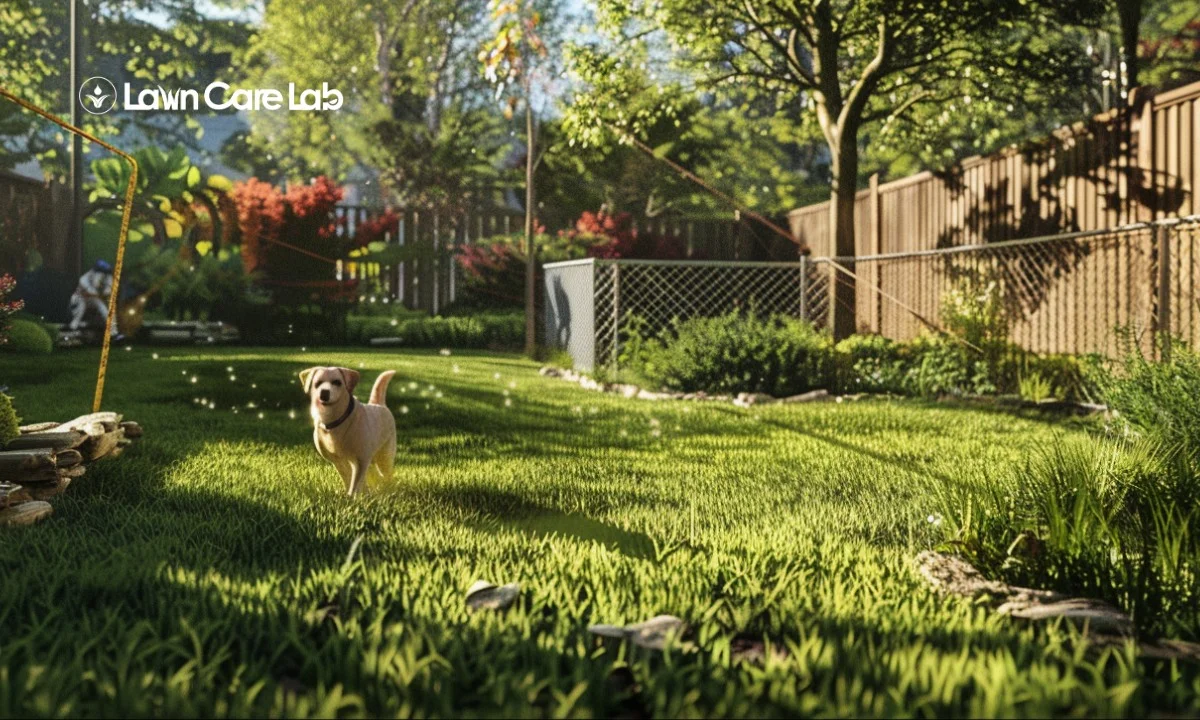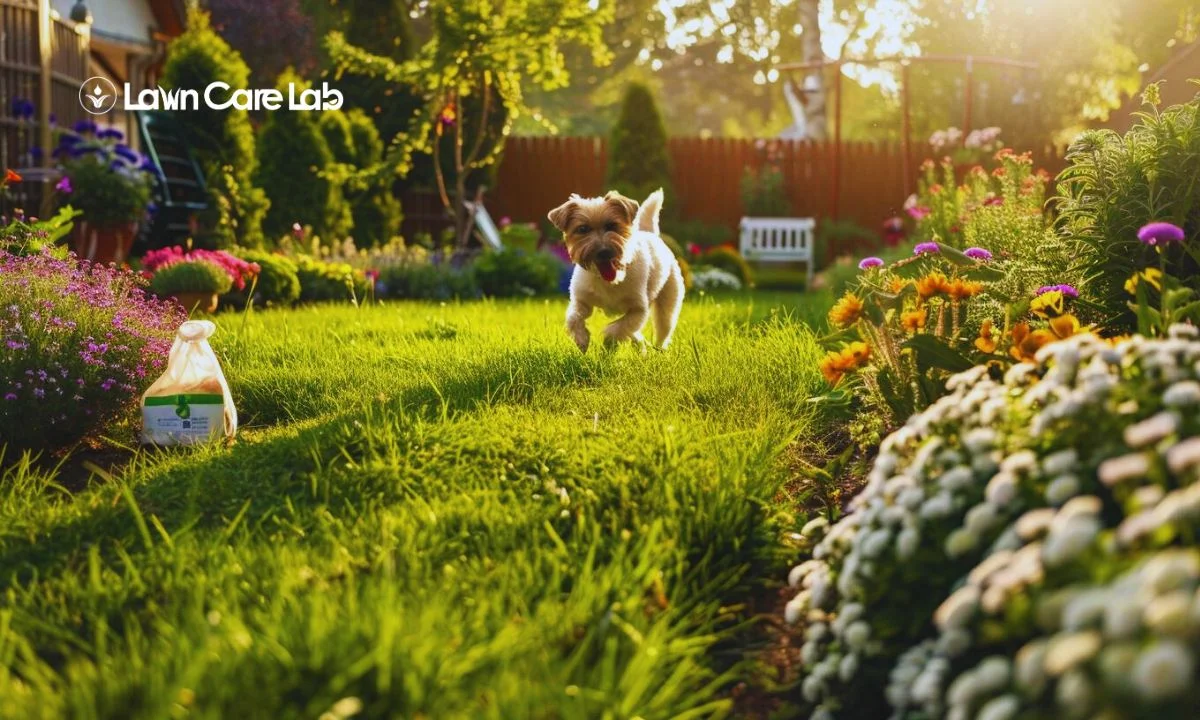You’re on a quest for the ideal lawn, and Bermudagrass could be your knight in shining armor. This hardy grass species can withstand high temperatures, requires little watering, and is incredibly durable – making it the perfect ally against harsh weather conditions and heavy foot traffic.
In this article, we’ll dig into everything you need to know about harnessing the strength of Bermudagrass for your lawn needs.
Highlights
- Nutrients, such as phosphorus and potassium, are important for the development and resilience of Bermuda grass.
- Slow-release fertilizers are available to gradually deliver nutrients to Bermuda grass, minimizing wastage and maximizing efficiency.
- The timing of fertilizing Bermuda grass is crucial for effectiveness, with the optimal period being late spring to early summer.
- Proper mowing techniques, including setting the mower blade at the recommended height and frequently at a moderate height, contribute to the health and resilience of Bermuda grass.
Table of Contents
Introduction to Bermudagrass
Bermudagrass seed has a unique ability to establish itself quickly and form a dense turf. It thrives in warm climates, making coastal bermudagrass varieties particularly popular in sunny regions.
One key characteristic you’ll appreciate is its tendency to produce runners – both above-ground (stolons) and below-ground (rhizomes). These bermudagrass runners are instrumental in its quick recovery from damage.
Navigating through the different bermudagrass growth stages requires knowledge and patience.
Each stage demands distinct care strategies, from seeding or laying bermudagrass sod to nurturing mature lawns.
With proper maintenance, you can expect a lush green carpet that’s aesthetically pleasing and resistant to pests and diseases.
Key Characteristics of Bermudagrass
Now, let’s delve deeper into understanding the key characteristics of Bermudagrass.
You’ll discover its growth habit is unique, boasting stolons and rhizomes, enabling it to spread quickly and efficiently.
Growth habit (stolons, rhizomes)
Bermudagrass has a unique growth habit that sprouts both stolons and rhizomes. This gives it incredible resilience, making your lawn lush and hardy.
Stolons, or runners, are sent across the ground surface, while rhizomes grow beneath the soil. These components intertwine to form a dense mat of bermudagrass roots, making it tough to penetrate.
As the bermudagrass seed head matures, it produces more seeds, continuing its aggressive propagation cycle. Managing bermudagrass requires understanding its strength and potential invasiveness.
Appearance and identification (leaf shape, seed heads)
Take a moment to appreciate this resilient grass’s distinct appearance and identification markers, such as its unique leaf shape and seed heads. This fine-textured turfgrass’s visual appeal adds an innovative edge to every lawn it graces.
Distinguishing characteristics include:
- The leaves: They are flat, narrow, and pointed at the tip with rough edges that give bermudagrass a distinctive texture.
- The color: A lush, deep green hue that can transform your lawn into an emerald paradise.
- The seed heads: These are spike-like structures extending upwards from the base giving it a feathery look.
- The stolons and rhizomes: Visible creeping stems aboveground or beneath contribute to its rapid spreading ability.
Establishing Bermudagrass
If you’re considering establishing Bermudagrass, understanding the key methods such as seeding, sprigs, and sod can greatly influence your success. Each method has unique advantages and challenges, requiring specific care to ensure robust growth.
Seeding
Let’s not forget the crucial step of seeding your lawn, especially when dealing with tough and resilient bermudagrass.
Seeding can seem daunting, but it doesn’t have to be. Precision and timing are key; plant your seeds in late spring or early summer for maximum yield.
- Start by preparing your soil.
- Till it up lightly and remove any debris that might hinder seed germination.
- Once done, broadcast your bermudagrass seeds evenly across the surface. Remember, innovation also counts here – consider using advanced seeding tools for uniform distribution.
Afterward, water regularly but avoid overwatering as that could wash away the seeds.
Sprigs
Sprigging bermudagrass offers an innovative, cost-effective solution for rejuvenating your lawn. Unlike seeding, it provides near-instant coverage, creating a uniform carpet of green in record time.
To ensure success with sprigs, preparation is key.
- Create an optimal environment by loosening the soil and adding organic matter.
- Place sprigs 6 inches apart and cover lightly with soil to encourage rapid growth.
- Water them diligently; they need consistent moisture until firmly established.
Leveraging sprigs can bring about a verdant transformation in your yard, harnessing bermudagrass’s robust characteristics for superior lawn performance.
Sod
While sprigs offer a certain appeal, you’ll find sod an even more rapid solution for achieving that coveted green paradise. Sod is essentially mature bermudagrass that’s been expertly grown and harvested, ready to be laid out on your lawn. It offers instant gratification and a robust, uniform look.
Investing in sod can accelerate the beautification of your outdoor living space, saving time while still harnessing the toughness of bermudagrass. Imagine transforming bare soil into a lush lawn almost overnight!
Bermudagrass sod installs easily, and its dense growth habit quickly crowds out weeds.
Caring for Established Bermudagrass
Once you’ve successfully established your Bermudagrass lawn, it’s crucial to maintain its lush green appearance and strength through proper care.
This includes understanding the watering needs of your grass, implementing an effective fertilization schedule, consistent mowing to promote growth, and maintaining thatch control to prevent damage.
Watering needs
Bermudagrass doesn’t require constant watering, making it a drought-tolerant option for your lawn.
This resilient grass species adapts well to various soil types and can withstand high heat and sunlight – perfect for those daring to innovate in their garden design.
To manage the watering needs of your Bermudagrass lawn effectively, consider these four points:
- Initial Watering: After planting, water thoroughly until the top 6-8 inches of the soil is moist.
- Routine Hydration: Regularly water lightly to keep the top inch of soil damp until new growth appears.
- Mature Lawn Care: Once established, only water when you notice signs of wilting or color changes.
- Seasonal Adjustments: Reduce watering during dormant winter months.
With proper understanding and care, Bermudagrass can be a powerfully sustainable choice for your innovative lawn needs.
Fertilization
Understanding the fertilization process is like painting a masterpiece, with each nutrient acting as a vibrant color that contributes to your garden’s overall health and beauty.
For Bermuda grass, nitrogen is the primary color on your palette. This essential nutrient ensures robust growth and vibrancy in your lawn’s green hue.
However, it’s important not to overlook the other nutrients, as they play vital supporting roles. Phosphorus, for example, aids in root development, while potassium strengthens resistance against drought and disease.
Innovative products now offer slow-release fertilizers specifically designed for Bermuda grass. These fertilizers gradually deliver nutrients over time, minimizing wastage and maximizing efficiency.
Remember, correct timing is crucial too! The optimal period for fertilizing Bermuda grass is during its peak growth season, late spring to early summer.
Mowing
Having fortified your bermudagrass with the right nutrients, it’s time to turn our attention to another essential aspect of lawn care – mowing.
Mowing isn’t just about keeping your grass looking neat; it’s an art that contributes significantly to the health and resilience of your lawn. Setting your mower blade at the recommended height for bermudagrass encourages denser growth and better shade tolerance.
Frequent mowing at a moderate height is key in maintaining a lush green carpet of this hardy grass variety.
However, ensure not to cut off more than one-third of the leaf blade at once, as this can stress the plant and inhibit its ability to photosynthesize efficiently.
Thatch control
With its vigorous growth, Bermudagrass can accumulate thatch–a layer of dead grass and root material between the soil surface and green vegetation. Not properly managed, it stifles your lawn’s potential.
Here’s an innovative approach to managing thatch in your bermudagrass:
| Technique | Description | Frequency |
|---|---|---|
| Vertical Mowing | It uses a special rake or machine to pull up excessive thatch. | As needed |
| Core Aeration | Removes small cores of soil and thatch from the lawn to improve nutrient absorption. | 1-2 times/year |
| Thatch Raking | Uses a special rake or machine to pull up excessive thatch. | As needed |
The Challenge of Controlling Bermudagrass
While the resilience of Bermudagrass can be a boon for your lawn, it may also pose challenges when attempting to control its growth.
You might explore various prevention methods, such as using preemergent or mulch, selecting selective herbicide control to manage its spread, or even considering complete removal approaches like tillage and solarization.
Prevention methods (preemergent, mulch)
To effectively prevent unwanted bermudagrass growth, there are two main methods: applying preemergent herbicides and using mulch. Preemergent herbicides act as your first line of defense, inhibiting germination and stopping potential problems before they become visible.
Mulching is another innovative method that can be used. Organic mulch hinders weed growth and enriches the soil as it decomposes, promoting healthier grass growth. It acts as a protective blanket for your lawn, retaining moisture and preventing erosion.
Timing is critical when using these prevention methods. It is important to apply pre-emergents early in the growing season and replenish mulch regularly for optimal results. Utilizing these techniques allows you to maintain an enviable lawn year round.
Selective herbicide control
While prevention methods like preemergent treatments and mulching are crucial in managing bermudagrass, more aggressive measures may sometimes be necessary.
That’s where selective herbicide control comes into play. This innovative technique lets you target unwanted vegetation without causing harm to your desired plants.
Selective herbicides exploit the natural differences between plant species, allowing them to kill off weeds while leaving your bermudagrass untouched. It’s a smart way to enhance the strength of your lawn with minimal collateral damage.
Complete removal approaches (tillage, solarization)
When dealing with stubborn bermudagrass invasions, tillage is an innovative method that turns the soil over and uproots the grass. This procedure may need repetition for total eradication, but it’s a potent strategy.
Solarization packs another punch in your fight against unyielding bermudagrass.
By spreading clear plastic sheets over the invaded area and leaving them there during the hottest part of the year, you harness the power of sunlight to superheat and sterilize your soil. This process not only wipes out bermudagrass but also eliminates other weeds and pests—giving you a clean slate for your lawn dreams.
Conclusion
Bermudagrass is known for its ability to withstand drought and heat. It has a deep root system allows it to access water and nutrients from the soil efficiently. This makes it an excellent choice for areas with hot and dry climates.
Once your Bermudagrass is established, it’s important to provide proper care. Regular mowing is necessary to keep the grass at an optimal height.
While Bermudagrass is a resilient and hardy grass, controlling it can be challenging. It tends to spread rapidly, invading flower beds and other areas of your lawn. Regular edging and maintenance can help keep it in check.
FAQs on Bermudagrass
What causes Bermuda grass to be invasive?
Can Bermuda grass outcompete weeds?
Is Bermuda grass a magnet for insects?
Does Bermuda grass absorb water well?
What is the best way to eliminate weeds in Bermuda grass?
What type of fertilizer is best for Bermuda grass?
What is the recommended cutting height for Bermuda grass?
Is it possible to plant Bermuda grass in autumn?
- How to Create a Lawn Care Schedule for Southern Climates - October 30, 2024
- How to Use Compost Tea to Boost Lawn Growth and Soil Health - October 23, 2024
- The Best Grasses for Saltwater-Exposed Lawns: Coastal Lawn Care - October 17, 2024




